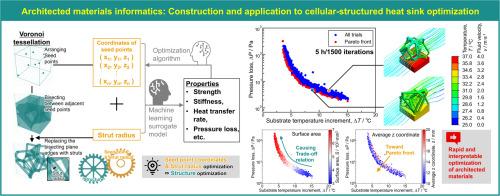建筑材料信息学:细胞结构散热器优化的构建与应用
IF 9.3
1区 材料科学
Q1 MATERIALS SCIENCE, MULTIDISCIPLINARY
引用次数: 0
摘要
增材制造允许有意控制成型材料的几何形状,以实现所需的性能。在广阔的搜索空间内设计和优化结构材料的几何形状非常重要。本研究将 Voronoi 镶嵌法与信息学相结合,构建了用于几何优化的建筑材料信息学。Voronoi tessellation 可以通过在任意排列的种子点之间用二叉平面划分设计空间,并用实体支柱取代二叉平面边缘,从而设计出多样化的建筑材料。神经网络代用模型根据种子点坐标和支柱半径预测拱形材料的属性。遗传算法对代理模型进行反向分析,以优化种子点坐标和支柱半径,并将其与优化后的拱形材料几何形状直接联系起来。该框架快速优化了蜂窝结构散热器的几何形状,在强制对流条件下优化平衡了压力损失和热传递(帕累托前沿)。帕累托前沿的优化几何形状通过计算流体动力学和实验进行了验证。此外,还对优化过程中获得的数据进行了分析,以制定改善压力损失和热传递权衡的策略。这项研究提供了建筑材料信息学框架,以优化建筑材料的几何形状,满足不同应用的需要。本文章由计算机程序翻译,如有差异,请以英文原文为准。


Architected materials informatics: Construction and application to cellular-structured heat sink optimization
Additive manufacturing permits intentionally controlling the geometry of architected materials to achieve desired properties. It is important to design and optimize the geometry of architected materials within a wide search space. This study integrates Voronoi tessellation and informatics to construct architected materials informatics for geometry optimization. Voronoi tessellation can design diverse architected materials by dividing a design space with bisecting planes between arbitrarily arranged seed points and replacing the bisecting plane edges with solid struts. The neural network surrogate model predicts the properties of the architected materials based on the seed point coordinates and the strut radius. The genetic algorithm inversely analyzes the surrogate model to optimize the seed point coordinates and strut radius directly linked to the optimized architected material geometry. This framework rapidly optimized the geometry of cellular-structured heat sinks, optimally balancing pressure loss and heat transfer (Pareto front) under forced convection. The optimized geometry of the Pareto front was validated using computational fluid dynamics and experiments. In addition, the data obtained during the optimization was analyzed to develop a strategy to improve the pressure loss and heat transfer trade-off. This study provides architected materials informatics framework to optimize the geometry of architected materials for diverse applications.
求助全文
通过发布文献求助,成功后即可免费获取论文全文。
去求助
来源期刊

Acta Materialia
工程技术-材料科学:综合
CiteScore
16.10
自引率
8.50%
发文量
801
审稿时长
53 days
期刊介绍:
Acta Materialia serves as a platform for publishing full-length, original papers and commissioned overviews that contribute to a profound understanding of the correlation between the processing, structure, and properties of inorganic materials. The journal seeks papers with high impact potential or those that significantly propel the field forward. The scope includes the atomic and molecular arrangements, chemical and electronic structures, and microstructure of materials, focusing on their mechanical or functional behavior across all length scales, including nanostructures.
 求助内容:
求助内容: 应助结果提醒方式:
应助结果提醒方式:


